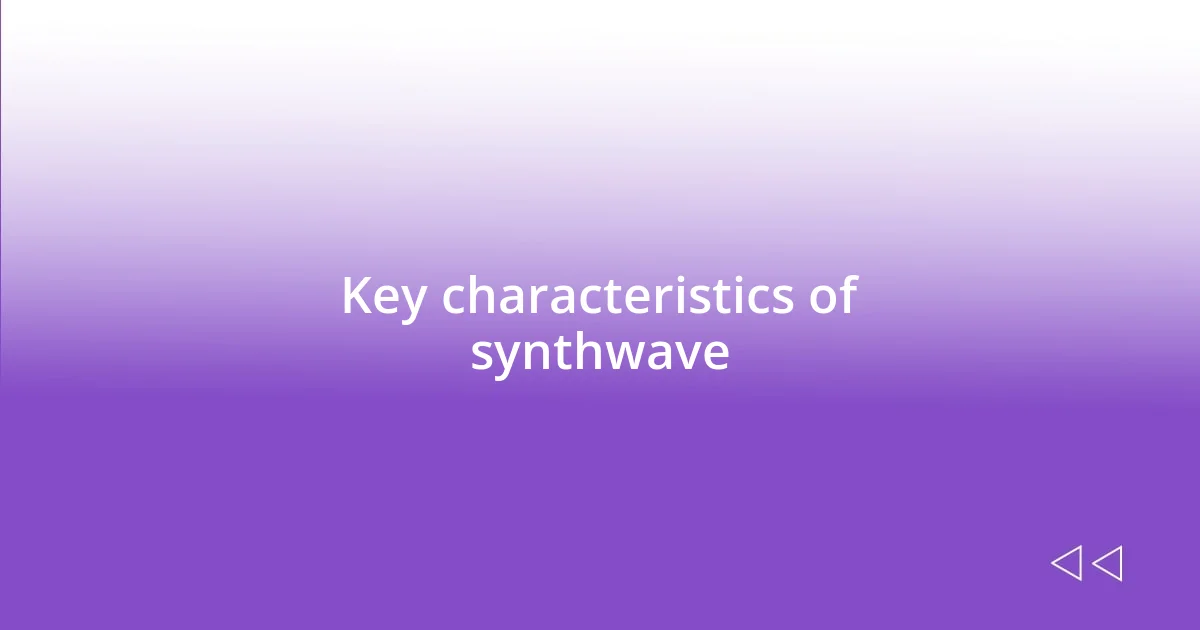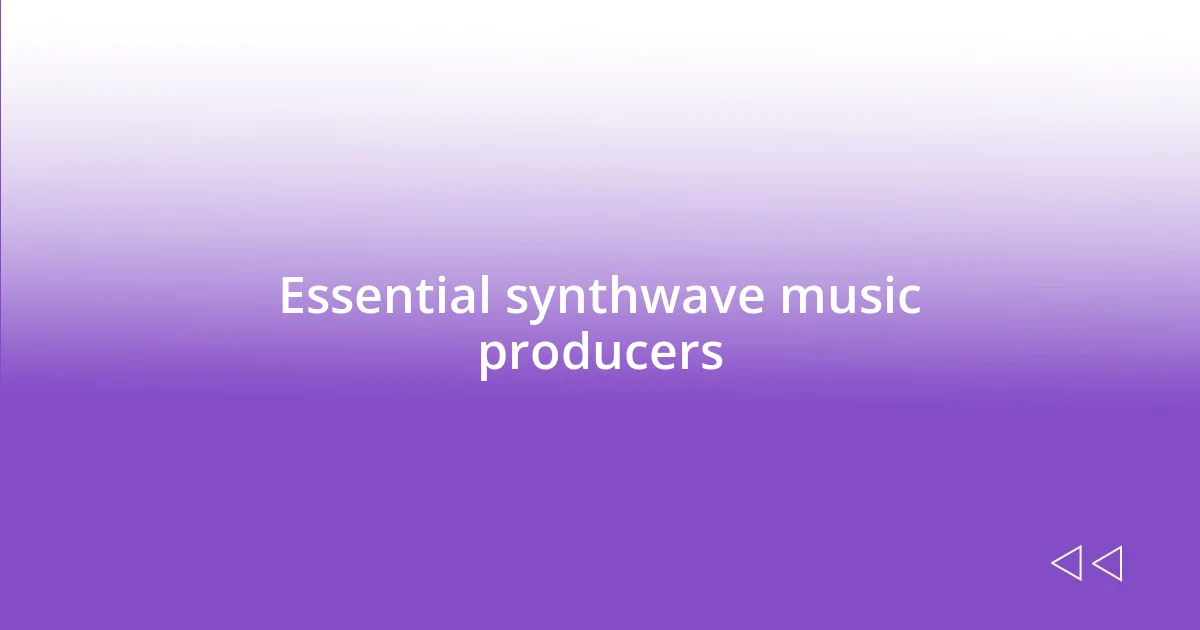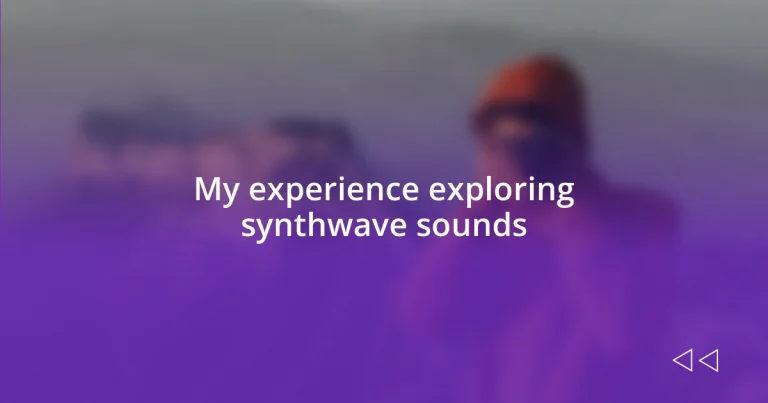Key takeaways:
- The author’s initial encounter with synthwave music evoked strong emotions and memories of the 1980s, leading to a deep appreciation for the genre.
- Synthwave is characterized by its use of synthesizers, nostalgic themes, beat-driven rhythms, and vibrant visual aesthetics that complement the music experience.
- Essential synthwave producers like Kavinsky, Perturbator, and FM-84 create tracks that enhance emotional resonance and transport listeners to vivid, nostalgic landscapes.

My introduction to synthwave sounds
I vividly remember the first time I stumbled upon synthwave sounds while scrolling through a music app late at night. The vibrant, nostalgic melodies took me back to the 80s— a decade I only experienced through movies and pop culture. How could this sound, so rich in layers, evoke such vivid memories that I never actually lived?
As I delved deeper into the genre, I was captivated by its unique blend of electronic beats and retro aesthetics. I often found myself putting on my headphones and losing track of time, immersed in tracks that felt like scenes from a neon-lit cityscape. Have you ever experienced music that transports you to another world? That’s exactly how I felt, and I began to explore artists like Kavinsky and Gunship, who masterfully evoke emotions tied to nostalgia and adventure.
One evening, I sat on my balcony, the stars twinkling above me, and pressed play on my growing synthwave playlist. With each pulse of sound, it was as if the music was wrapping around me like a warm blanket, stirring something deep within. I began to wonder: what is it about these synth-driven tunes that resonates so profoundly? That moment marked the beginning of my love affair with synthwave sounds, transforming the way I perceived music and its connection to memory.

Understanding the synthwave genre
Synthwave is more than just a music genre; it’s a vibrant homage to the 1980s aesthetic. Rooted in electronic music, it fuses nostalgic melodies with modern production techniques. I remember listening to a synthwave track during a late-night drive, and the shimmering synths made the city lights feel even more mesmerizing, as if I were gliding through a dreamscape.
To really grasp the essence of synthwave, consider its key elements:
- Synthesizers: The backbone of the genre, creating lush soundscapes and catchy melodies.
- Nostalgia: The music often evokes feelings tied to pop culture from the 80s, like retro films and arcade games.
- Beat-driven: Pulsating rhythms that hook you in and create an infectious energy.
- Visual Aesthetics: The associated artwork often features neon colors and retro imagery, enhancing the experience.
- Emotional Resonance: Tracks frequently explore themes of love, loss, and adventure, tapping into universal feelings.
Every time I dive into a synthwave track, I feel as if I’m rediscovering a piece of myself, wrapped in the warmth of familiarity. It’s this blend of nostalgia and innovation that keeps pulling me back, like an old friend, inviting me to explore once again.

Key characteristics of synthwave
When I think about synthwave, one characteristic that stands out is its unmistakable use of synthesizers. Imagine walking into a vibrant arcade bathed in neon lights; that’s the feeling these synthesizers evoke. I recall having a late-night jam session at home, where I attempted to recreate the captivating sounds I loved so much. The lush layers of synth created a sense of space that felt limitless, almost as if the music could physically transport me somewhere else, reinforcing the genre’s core characteristic of atmospheric soundscapes.
Another key aspect that strikes me about synthwave is its emotional depth. Walking through the city on a rainy night, I often find myself playing tracks that echo my mood—songs filled with wistfulness and nostalgia. I’ve found myself daydreaming while listening to lush melodies that evoke feelings of a bittersweet romance, reminding me of the times I felt connected to the past while forging new memories in the present.
Lastly, the visual aesthetics of synthwave truly enhance its sonic experience. I remember diving into a playlist filled with tracks that echoed themes of 80s movies and retro games, only to discover striking artwork that perfectly mirrored the music’s vibe. The neon-hued visuals that often accompany synthwave music aren’t just for show; they complement the sound, creating a fuller experience. Each time I see graphic art that evokes this aesthetic, it reminds me that synthwave is not just a listening experience but a feast for the eyes too.
| Characteristic | Description |
|---|---|
| Synthesizers | Key instruments that create lush, atmospheric soundscapes. |
| Emotional Depth | Tracks often explore themes of nostalgia, love, and adventure. |
| Visual Aesthetics | Accompanying graphic art features vibrant neon colors and retro styles. |

Essential synthwave music producers
When I explore synthwave, a few producers consistently stand out for their unique contributions to the genre. One of my favorites is Kavinsky, whose track “Nightcall” seems to awaken a blend of nostalgia and mystery each time I hear it. I still vividly remember the first time it played in the background of a late-night coffee run; the haunting melodies and pulsating beat transported me to a moonlit drive through an open highway.
I can’t talk about essential producers without mentioning Perturbator. His albums are like a sonic journey through a neon-soaked cityscape, echoing both danger and beauty. I recall getting lost in his track “Venger,” where every synth line pulled me further into a world drenched in 80s influences while pushing modern boundaries. Those moments help me realize how impactful his sounds can be—they’re not so much songs as they are vivid experiences that stick with you long after they’ve ended.
Another producer who captures my heart is FM-84. The track “Running in the Night” is a pure adrenaline rush, mixing euphoric melodies with heartfelt lyrics. I can’t count how many times I’ve turned up the volume, racing down the local streets with the windows down, feeling a sense of freedom that only the right soundtrack can evoke. Doesn’t that kind of connection remind you of the joy found in music that resonates with our own adventures? For me, it’s in these shared journeys that synthwave truly thrives.

Exploring popular synthwave tracks
Exploring popular synthwave tracks often feels like opening a door to a world of vibrant emotions and memories. One track that really draws me in is “Turbo Killer” by Carpenter Brut. The first time I heard it, I found myself lost in an epic rush of adrenaline, as if I were racing through a futuristic city at breakneck speed. It’s that combination of driving bass and soaring synths that electrifies my senses and makes me crave more of that exhilarating experience.
Then there’s the haunting beauty of “A Real Hero” by College, featured in the iconic film “Drive.” I’ll never forget those late nights when I’d put this track on repeat. Each note resonates with a bittersweet longing, reminding me of significant moments when time seemed to stand still. What is it about certain songs that capture one’s emotions like that? I believe it’s the raw honesty embedded in melodies that allows us to connect so deeply.
Another standout is “Lose Yourself to Dance” by Daft Punk. While it leans more towards the electronic side, the synth-heavy sound and funky grooves embody that synthwave spirit. Dancing alone in my living room while this track plays brings such joy—it’s like an invitation to forget my worries and just move. Have you ever felt that euphoric release that music can offer? For me, these moments are a testament to how synthwave tracks become the backdrop to our lives, effortlessly weaving through our memories and emotions.

Techniques for creating synthwave sounds
Creating synthwave sounds involves blending elements that evoke nostalgia, yet feel fresh and modern at the same time. I’ve found that using lush, warm synths is key; they transport listeners directly back to the 1980s. For instance, while experimenting with my Korg Minilogue, I stumbled upon a rich pad sound that felt just right, reminiscent of summer nights under neon lights. Have you ever discovered a sound that instantly connected you with a specific time and place? That moment captured my essence of synthwave.
Beyond the synths, layering is another technique that brings depth to synthwave tracks. I often create a base of driving basslines, then experiment with adding arpeggios or rhythmic patterns on top. One evening, I layered a punchy bass with a shimmering arpeggio, and the result was mesmerizing. The way those sounds intertwined made me feel like I was cruising through a digital landscape; isn’t it amazing how such combinations can evoke imagery and emotion simultaneously?
Effects also play a vital role in crafting synthwave. I love to sprinkle in reverb and chorus to give my tracks that expansive, dreamy quality. A few weeks ago, I was tweaking a track and added a touch of delay. It brought my synth lead to life, making it resonate beautifully. There’s something magical about finding that perfect effect: it’s as though you’ve breathed individuality into the sound. Have you ever experienced that thrill when a sound just clicks? For me, those are the moments when music transforms into magic.














